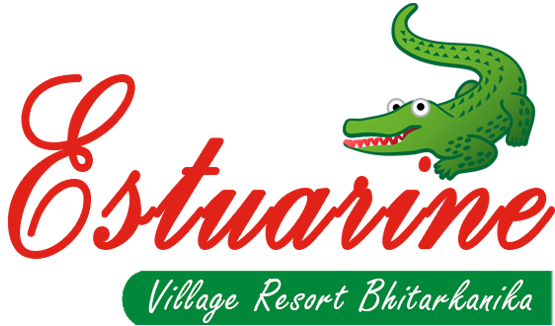Bhitarkanika is India’s second largest mangrove ecosystem after the Sunderbans. The National park is essentially a network of creeks and canals which are inundated with waters from rivers Brahmani, Baitarani, Dhamra and Patasala forming a unique ecosystem. Bhitarkanika is home to the largest congregation of the endangered Salt Water Crocodile in the country.
Bhitarkanika National Park
Bhitarkanika Wildlife Sanctuary
An area of 672 square Kilometer was designated as Bhitarkanika Wildlife Sanctuary through a notification in 1975. The Sanctuary comprises of mangrove forest with diverse variety of flora species, and has river channels of different dimensions meandering through it.
The Sanctuary was formed to conserve the endangered salt water crocodiles, also called estuarine crocodiles. Besides these large crocodiles, the Sanctuary is rich in avifauna, mammalian and reptilian population. This has proved to be a good habitat for cobras, Indian Python and Water and Monitor Lizards.
A large number of water birds visit Bhitarkanika every year with the onset of monsoon. These birds remain in Bhitarkanika Sanctuary Area almost till the middle of November, when they start migrating out from here. The migratory birds include the various varieties of Stork birds, most prominent being Asian Open Bill storks. They migrate here in huge numbers. Some Asian Open Bill storks have made Bhitarkanika their permanent residence and have become natives of this land.
Some bird varieties like egrets, black ibis, cormorants, darters, parakeets, and kingfishers are natives of Bhitarkanika and are found in good numbers.
Bhitarkanika National Park
The core area of Bhitarkanika Wildlife Sanctuary has been notified as Bhitarkanika National Park since 1998. This is spread over an area of 145sq km. This area has much significance with regard to ecological aspects which include mangrove forests, rivers, creeks, backwaters, estuaries and salt water crocodiles. This National Park in Odisha has one of the biggest estuarine crocodile habitats in India.
Time to Visit
Open For Tourists: 1st August to 30th April every year
Closed for Tourists: 1st May to 31st July every year and for around 10 days in Winters (usually in the 1st and 2nd week of January. Dates are, however, not fixed and can change from year to year) for Crocodile and bird census
Best time to visit for birds: – 1st August to 20th November
Best time to visit for crocodiles: – 1st October to 20th of April
Gahirmatha Marine Sanctuary
Stretch of water body from old light house near Batighar to Maipura river mouth was declared as Gahirmatha Marine Sanctuary in 1997. This is world’s largest known rookery of Olive Ridley sea turtle. Mass congregation of Olive Ridley turtles for mating and nesting enthralls both the scientists and nature lovers throughout the world. It was the rarity of mass congregation and the cruelty meted out to these innocent marine creatures which paved the way for creation of Gahirmatha (Marine) Wildlife Sanctuary.
Gahirmatha Sanctuary has a stretch of virgin beach from Barunei mouth to Ekakula. This huge beach stretch is accessible at a few places – Habalikhati and Pentha being the most prominent ones. Pollution free, serene surrounding, casuarinas trees doting beach stretch at several places and flat bed – all these make the beaches a treat for tourists and beach lovers.
The total area of the sanctuary is 1435 Square Kilometer which includes 1408 Square Kilometer of water body and 27 Square Kilometer of land mass including reserve forests, mud flats and accreted sand bars. Core area of the sanctuary consists of 725.50 Square Kilometer and the buffer zone accounts for 709.50 Square Kilometer. The entire sanctuary area comes within the revenue district of Kendrapara.
One can visit Habalikhati and stay at accommodations provided by the Odisha Forest Department. Habalikhati can, however, be accessed by boat only and it takes quite a few hours to reach there from the mainland where vehicles will drop you.
You can enjoy the stunning beach and also the forest area that run parallel to the beach. Some good bird sightings are also possible at Habalikhati.
